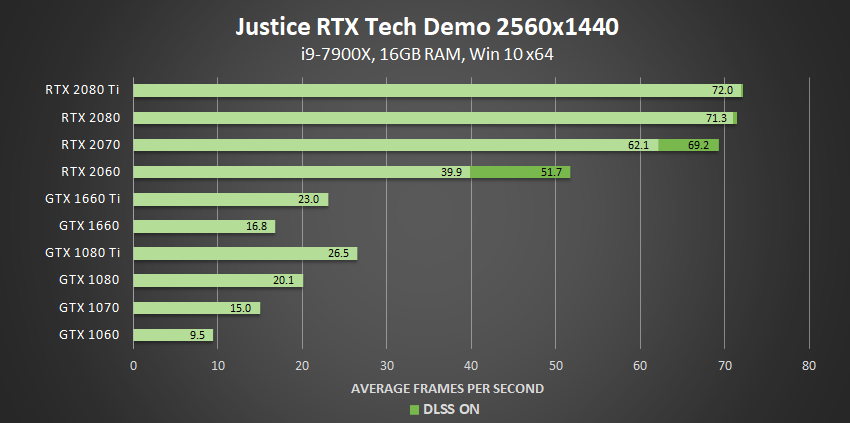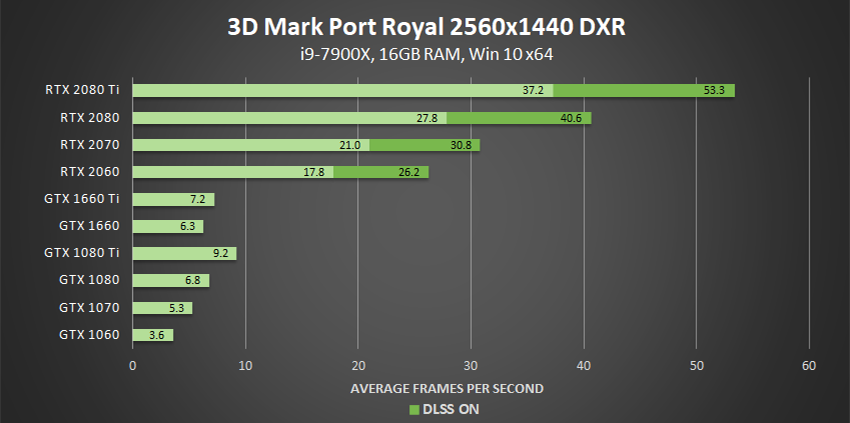That was their april fools jokeNVIDIA gave PCGH an updated version of their StarWars demo that uses DX12 and runs on Pascal too. PCGH tested Pascal GPUs @1440p native, versus Turing GPUs @2160p/DLSS. Which means Turing is at a moderate disadvantage here, as DLSS still incurs a performance loss even though it actually renders @1440p.
TitanXP: 11 fps
Titan RTX: 36 fps
1080Ti: 11 fps
2060: 17 fps
2070: 21 fps
2080: 27 fps
2080Ti: 35 fps
http://www.pcgameshardware.de/Nvidi...pecials/Pascal-Raytracing-Benchmarks-1278592/
Install the app
How to install the app on iOS
Follow along with the video below to see how to install our site as a web app on your home screen.
Note: This feature may not be available in some browsers.
You are using an out of date browser. It may not display this or other websites correctly.
You should upgrade or use an alternative browser.
You should upgrade or use an alternative browser.
Next gen lighting technologies - voxelised, traced, and everything else *spawn*
- Thread starter Scott_Arm
- Start date
DavidGraham
Veteran
Nope, read the article again ..That was their april fools joke
The article is a true test masquerading as an April's Fools joke, initially it was titled as a BFV DXR performance on Pascal, after the 1st of April has passed, the true name of the test was revealed to be the StarWars demo. Which was actually benchmarked and validated on all GPUs using an updated demo.
Last edited:
Oh, was reading too hastily, but it's not actually new version of the software, they said it [the updated version] was given out during RTX 2070 launch and is the only application where software RTX is enabled.Nope, read the article again ..
The article is a true test masquerading as an April's Fools joke, initially it was titled as a BFV DXR performance on Pascal, after the 1st of April has passed, the true name of the test was revealed to be the StarWars demo. Which was actually benchmarked and validated on all GPUs using an updated demo.
They had the same test up long time ago but later removed. Back then Pascal rendered at native 4K but Turing did 1440p and DLSS upsacling. And they gave 1080Ti 10 fps. Which was reason to me to point out a 1080Ti seems to trace nearly as fast as 2060.
But other tests David had found gave 1080Ti only 5 fps.
Now PCGH gets again 10(11) FPS on 1080Ti but this time at 1440p, so this finally clarifies their initial test (or my understanding of it) was wrong.
But other tests David had found gave 1080Ti only 5 fps.
Now PCGH gets again 10(11) FPS on 1080Ti but this time at 1440p, so this finally clarifies their initial test (or my understanding of it) was wrong.
I
imerso
Guest
I wonder what would be the performance of a 1080ti in "low res" such as 1280x720.
Why would you even add quotations to that, intimating that it's not low res? 1080p is low res nowadays.I wonder what would be the performance of a 1080ti in "low res" such as 1280x720.
I
imerso
Guest
Well, my first computer had 2kb of ram and 64x48 b/w graphics resolution.
A truly realtime and noiseless path-traced simulation in "just" 1280x720 (or even less!) today does not sound bad to me, honestly.
I will happily trade some resolution by fast noiseless path-tracing at any time.
I don't own a gtx1080ti yet, but will certainly buy one if it can reach noiseless TRUE path-tracing in 800x600@60fps already.
A truly realtime and noiseless path-traced simulation in "just" 1280x720 (or even less!) today does not sound bad to me, honestly.
I will happily trade some resolution by fast noiseless path-tracing at any time.
I don't own a gtx1080ti yet, but will certainly buy one if it can reach noiseless TRUE path-tracing in 800x600@60fps already.
Talk about McGuires DDGI now online: https://www.gdcvault.com/play/1026182/
Interesting: Glossy reflections (1.1ms) are computed as perfect mirrors first and then blurred in screenspace by roughness. (Like i had mentioned to be possible with CryEngine demo which does not jitter rays. This should be faster because less divergent ray directions and hit shading in any case.)
Diffuse probes (1ms) are placed in a regular grid, support infinite bounces, and have color and zbuffer (for occlusion when sampling). Probe update is stochastic and perf independent of scene (more complex scene will increase lag but perf remains more constant - the typical advantage we want by decoupling from the frame).
So this is very similar to what i'm doing but in a volume not on the surface. I tried it with SH volumes too many years ago but surface is faster and more accurate, but also more difficult and harder to integrate to existing engines.
Dynamic probes is one of the things i expected to see with RTX, and this tech seems much more useable than the 'classic and slow' approaches we see in UE4 IMO. I wonder we did not see this earlier. Imagine replacing the awful SSAO with RTAO and it would look pretty good i guess.
...oh, one thing that makes me a bit sad: Nowadays when you have a dynamic GI solution, you have to argument with 'decreasing production costs' before you even mention boring things like non static levels :|
Interesting: Glossy reflections (1.1ms) are computed as perfect mirrors first and then blurred in screenspace by roughness. (Like i had mentioned to be possible with CryEngine demo which does not jitter rays. This should be faster because less divergent ray directions and hit shading in any case.)
Diffuse probes (1ms) are placed in a regular grid, support infinite bounces, and have color and zbuffer (for occlusion when sampling). Probe update is stochastic and perf independent of scene (more complex scene will increase lag but perf remains more constant - the typical advantage we want by decoupling from the frame).
So this is very similar to what i'm doing but in a volume not on the surface. I tried it with SH volumes too many years ago but surface is faster and more accurate, but also more difficult and harder to integrate to existing engines.
Dynamic probes is one of the things i expected to see with RTX, and this tech seems much more useable than the 'classic and slow' approaches we see in UE4 IMO. I wonder we did not see this earlier. Imagine replacing the awful SSAO with RTAO and it would look pretty good i guess.
...oh, one thing that makes me a bit sad: Nowadays when you have a dynamic GI solution, you have to argument with 'decreasing production costs' before you even mention boring things like non static levels :|
Last edited by a moderator:
https://www.gdcvault.com/play/1026159/
Metro Exodus ray tracing presentation. Includes footage of emissive and local area lights (with soft shadows).
It makes a good case as to why ray ratracing is here to stay. Old school stuff just doesn't compare.
Metro Exodus ray tracing presentation. Includes footage of emissive and local area lights (with soft shadows).
It makes a good case as to why ray ratracing is here to stay. Old school stuff just doesn't compare.
Diffuse probes (1ms) are placed in a regular grid, support infinite bounces, and have color and zbuffer (for occlusion when sampling).
Aren't they in essence approximate ray tracing acceleration structures?
This talk is awesome covering the very important topic of an artist's perspective on authoring content with RT GI in mind vs. without it and maintaining both. Great stuff.https://www.gdcvault.com/play/1026159/
Metro Exodus ray tracing presentation. Includes footage of emissive and local area lights (with soft shadows).
It makes a good case as to why ray ratracing is here to stay. Old school stuff just doesn't compare.
Also, it is good to see a more coherent explanation of even why indoor scenes in Metro Exodus can be darker on the shadow side of an object, the use RT AO indoors!
Lastly! YES! They are finally talking about emissives, area lights, and punctual light source GI which the technique supports in a very cheap manner (apparently only 0.5 ms more from what I was told). I had to keep my lips tight on that one for so long and really look forward to seeing perhaps elements of that being added via patches into Metro or in their next title. Arbitrary area light shape with proper shadows? Wow.
No, but having a regular volume of probes lets you index the right ones easily when shading the decoupled surface.Aren't they in essence approximate ray tracing acceleration structures?
The volume has some more advantages over the surface caching approach: Dynamic or small geometry can be excluded from expensive RT, and still it's easy to get shading information for them. This way it also allows for volumetric lighting, particles etc., and high temporal lag is acceptable even for fast moving objects.
Downside is inaccuracy. It can not do nice accurate area shadows as seen in Metro, it wastes a lot of perf / storage for empty space if volumetric lighting is not your priority. It also has the same thin walls problem as voxels. (There will be leaking - to prevent it they suggest to make thick walls.)
To improve both, one could use higher probe density at the surface and lower in empty space, but then you deal with traversing SVO or multilevel grids per pixel for shading (like Quantum Break). Doing it all on the surface becomes more attractive at some point.
But i guess you can have a higher update priority close to the surface to avoid wasting performance on empty space.
(hope that's correct... i only skimmed the video for now...)
Ofc you can also combine various tech, e.g. using this probe algo only for 2nd+ bounces. For the first bounce maybe taking a guess form it would help with denoising a more accurate solution like Metro.
https://www.gdcvault.com/play/1026159/
Metro Exodus ray tracing presentation. Includes footage of emissive and local area lights (with soft shadows).
It makes a good case as to why ray ratracing is here to stay. Old school stuff just doesn't compare.
This is a very nice talk.
Another great one. This presentation is incredibly well structured and also addresses multiple layers of industry impacts directly. This is A+ content.
A couple more:
Shadows of the Tomb Raider: Ray Tracing Deep Dive:
https://www.gdcvault.com/play/1026163
Ray-traced water caustics with DXR
https://www.gdcvault.com/play/1026161
Shadows of the Tomb Raider: Ray Tracing Deep Dive:
https://www.gdcvault.com/play/1026163
Ray-traced water caustics with DXR
https://www.gdcvault.com/play/1026161
DavidGraham
Veteran
More data about DXR performance on Pascal vs Turing .. Using demos:




More data about DXR performance on Pascal vs Turing .. Using games:







More data about DXR performance on Pascal vs Turing .. Using games:



Last edited by a moderator:
D
Deleted member 2197
Guest
Looks closer to a GTX 2060.You forgot the Medium DXR settings in BF5 where GTX 1080 Ti about matches RTX 2070
DavidGraham
Veteran
We've known from the old TitanV results that the less ray tracing you do, the less acceleration from RT cores you get.You forgot the Medium DXR settings in BF5 where GTX 1080 Ti about matches RTX 2070
Similar threads
- Replies
- 25
- Views
- 3K
- Replies
- 608
- Views
- 96K
- Replies
- 21
- Views
- 11K
- Replies
- 90
- Views
- 18K
- Replies
- 50
- Views
- 17K
